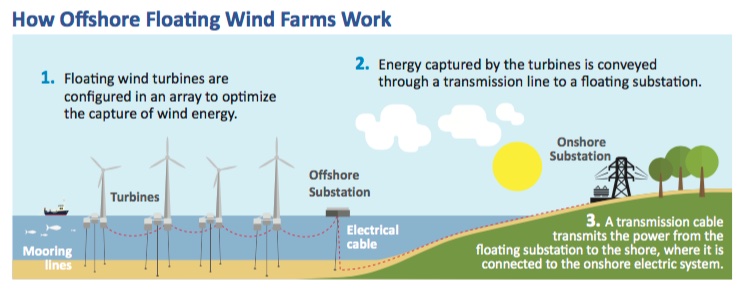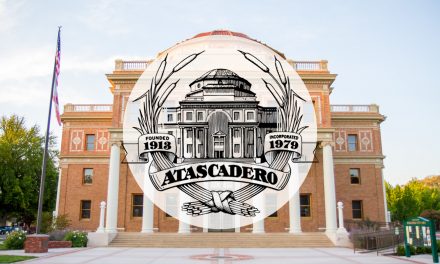Bureau of Ocean Energy Management begins “Environmental Analysis” for the “Morro Bay Wind Energy Area”
By Neil Farrell
CENTRAL COAST — The possibility of a giant offshore wind energy farm off the coast of San Luis Obispo County took a step forward in November when a federal agency moved the proposal into an environmental review phase.
The Bureau of Ocean Energy Management or BOEM announced on Nov. 12 that it had begun an “Environmental Analysis” (EA) for the “Morro Bay Wind Energy Area” or WEA, a 376 square mile patch of ocean — 240,898 acres — located some 20 miles off the coast at San Simeon.
An EA is part of the environmental review process under the National Environmental Policy Act, which is the federal version of the “California Environmental Quality Act” or CEQA. Though the two processes approach from opposite directions, they arrive at the same destination, purportedly an environmentally sound project whose every impact is either avoided or mitigated.
The Nov. 12 announcement reads, “BOEM will now prepare an Environmental Assessment as required under the National Environmental Policy Act, to consider potential impacts from site characterization activities [e.g., biological, archeological, geological, and geophysical surveys) and site assessment activities (e.g., installation of meteorological buoys] within the WEA. BOEM’s preparation of the EA will initiate a public comment period along with two virtual public meetings.”
BOEM will take public comments now through Jan. 11 at 11:59 p.m., the release said.
“Once BOEM considers all public input, the agency will publish a draft EA for public review and comment. The analyses contained in the EA will help BOEM determine whether to move forward with an area(s) for a proposed lease sale.”
The investigations into offshore wind energy was started by Trident Winds in 2016 when the company inquired into possibly developing a 1,000-megawatt wind farm offshore of the Central Coast. The initial area sought by Trident was offshore about 22 miles from Cayucos in some 20,000 feet of water.
But the Navy objected to that area as it sits in the midst of the flight training zone for Lemoore Naval Air Station. In response, BOEM asked if any other companies were interested and got several responses from U.S. and European energy companies. Now the number of interested companies numbers over a dozen, including several oil companies.
The State of California has an interest because of its ambitious climate change goals that are intended to lead California into a future with totally carbon-free energy generation. Since the State no longer considers nuclear energy desirable and will be completely nuke-free once Diablo Canyon closes in 2025, and there are no hydroelectric projects under consideration, that means wind and solar.
Since initiating the conversation, Trident has teamed up with German Energy company EnBW to form Castle Winds and is actively pursuing an operating license. Castle Wind and the City of Morro Bay signed a memorandum of understanding wherein the City has lent its support behind Castle’s proposal, and Castle has pledged to support the City financially.
It was Castle Wind’s leadership team that approached the Navy and worked out the current location off San Simeon for the offshore wind farm. Another local potential area south of Point Buchon off the Coast of Diablo Canyon was dropped after the Navy refused to give that area up.
Another Pacific Coast area is also being looked at off the Coast of Humboldt County, but that area lacks what Morro Bay has—an easy and existing connection to the power grid and capacity on the existing high voltage transmission wires that enter and exit the rear of the Morro Bay Power Plant.
President Biden recently issued an executive order calling on the development of offshore wind on the Pacific Coast of 4.5 gigawatts (a gigawatt is 1,000 megawatts). As an example, the Morro Bay Power Plant, when it was operational, had a capacity of just over 1,000 MW.
But that plant hasn’t been operational since 2014. The large commercial solar plants built several years ago in California Valley have taken advantage of the open capacity on the transmission wires to send their energy into the power grid.
Biden’s order and its focus on offshore wind energy potential caused the BOEM to expand the originally designated area up to 399 square miles, which this most recent pronouncement shrank back down to 376 square miles.
“Offshore wind presents a significant opportunity for California and our nation as we transition to clean, renewable energy. Today’s announcement represents significant progress towards that future,” said BOEM Director Amanda Lefton. “As the process continues, BOEM is committed to environmental reviews, which are critical for a strong resource management program, and to robust public engagement.”
Though little has been publicly announced since the start of all this in 2016, a check of the BOEM website for the project (visit boem.gov/renewable-energy/state-activities/morro-bay-wind-energy-area) shows the agency has been busy studying various aspects of the project, including such specific things as the “Potential Impacts of Submarine Power Cables on Crab Harvest;” to “Humpback Whale Encounter with Offshore Wind Mooring Lines and Inter-Array Cables.”
Many of these individual studies, some done with research universities and others with the California Energy Commission, have already been completed.
Those areas of study are listed in a BOEM summary report; visit boem.gov/sites/default/files/documents/renewable-energy/Selected-BOEM-Research-Renewable-CA_2.pdf.
Among the numerous engineering challenges the wind farms face are how to effectively and safely moor floating turbines that stand 600 feet tall from the ocean surface to the tip of the 200-foot fan blades moored in 800-1,000 feet of water.
On its website, Castle Wind names four types of anchors they could use from giant concrete blocks and anchor chains to so-called torpedo anchors — wherein a long steel tube with a point on one end is dropped off the side of a workboat and, sinking quickly, embeds itself into the seafloor.
It would be connected to the floating turbine via mooring chains, which have links that weigh upwards of 350 pounds each.
A second and perhaps more challenging obstacle is where to build the necessary maintenance yard. A Cal Poly study into the feasibility of the wind farms noted that such an operation would need at least 40 acres of land for a maintenance yard, located adjacent to a deep water port with a huge floating work quay.
President Biden, in his announcement on his executive order, touted the notion as having the potential to create thousands of good-paying union jobs. But just where will those jobs likely be created?
State Senator John Laird (D—17th District), in a recent interview, was asked about this because nowhere in San Luis Obispo County does such an area exist, and without hesitation, Sen. Laird said, “Port Hueneme,” which is located in Ventura County at Oxnard.
Though it won’t likely be part of BOEM’s EA on the project, the impacts of having to tow 600-foot tall turbines with a boat several hundred feet in length from Port Hueneme around Point Conception to San Simeon and back for maintenance is likely to have a significant impact on air quality, as well as the operations and maintenance costs, which traditionally are borne by electricity ratepayers.
Another potential issue is the Morro Bay area’s close proximity to the Monterey Bay National Marine Sanctuary, indeed the wind farm area under study hugs the western edges of that sanctuary, as well as the northern edges of the proposed Chumash Heritage NMS that the federal government has also recently moved forward (visit sanctuaries.noaa.gov/chumash-heritage).
BOEM plans to have its EA completed sometime in the spring and tentatively plans to hold a lease auction sometime in Summer 2022.
“Advancing both wind energy development and the sanctuary designation process in the area demonstrates the Biden-Harris Administration’s commitments to these important and complementary goals,” BOEM said.
Additional information on the Morro Bay WEA, public meetings, and how to comment can be found on BOEM’s website; visit boem.gov/MorroBayEA.
Resources: boem.gov/MorroBayEA
Biological Studies, page 1; Cultural & Archaeological Studies, page 7; Information Synthesis Studies, page 8; Physical Oceanography & Geology Studies, page 9; Resource, Technology & Infrastructure Studies page 10















